
Cell Biology
All living things are made up of either Prokaryotic or Eukaryotic cells. Eukaryotic cells are more complex than Prokaryotic. Eukaryotes (an organism composed of Eukaryotic cells) may be unicellular or multicellular. Prokaryotes (an organism composed of Prokaryotic cells) are typically unicellular. Animal, plant and microbe cells have similarities and differences in their Subcellular structures. Subcellular structures are just the different parts of a cell.
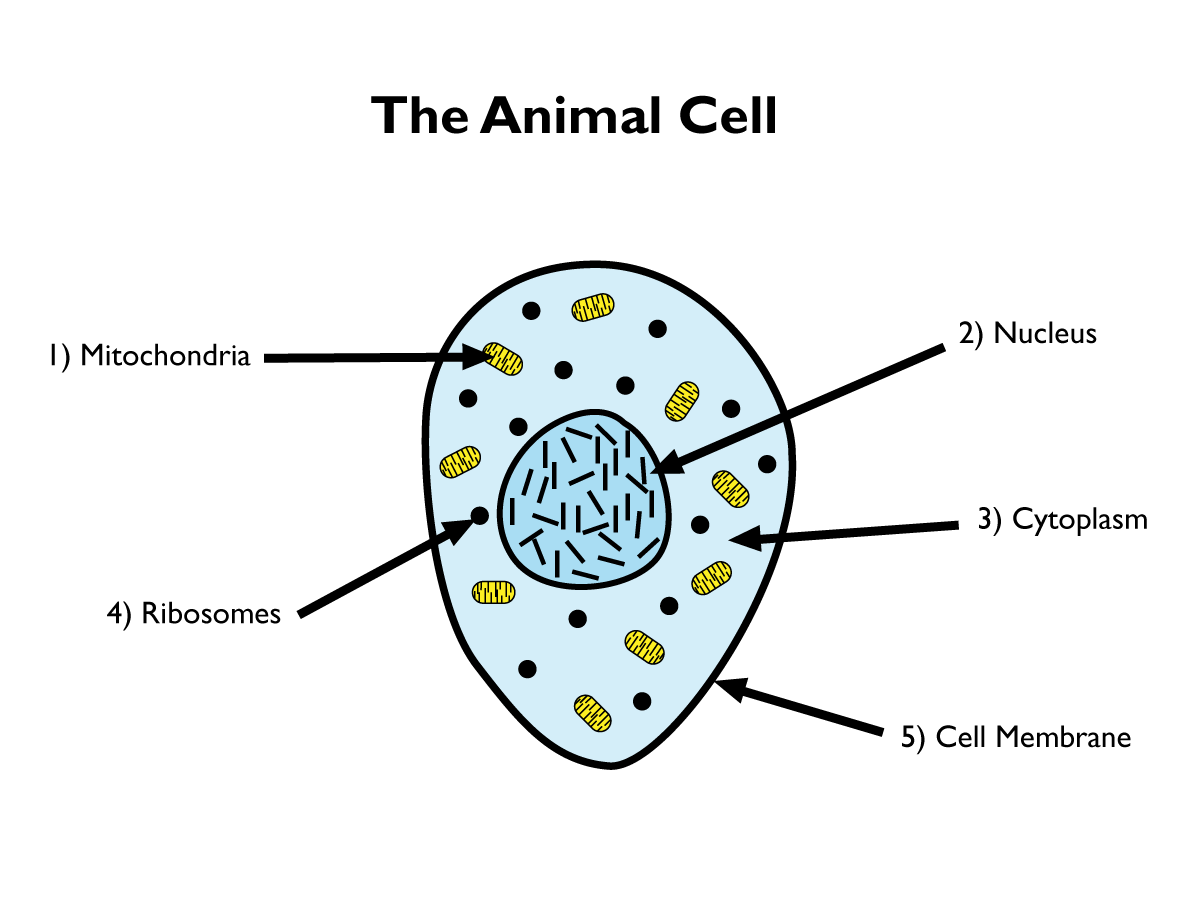
| Subcellular Structure | Function | |
|---|---|---|
| 1 | Mitochondria | Where aerobic respiration takes place. These reactions transfer energy to the cell |
| 2 | Nucleus | Contains genetic material called DNA that controls the cells activities |
| 3 | Cytoplasm | Contains enzymes that control the chemical reactions in the cell |
| 4 | Ribosomes | Where proteins are synthesized |
| 5 | Cell Membrane | Controls what goes in or out of the cell. And keeps the cell structure together |
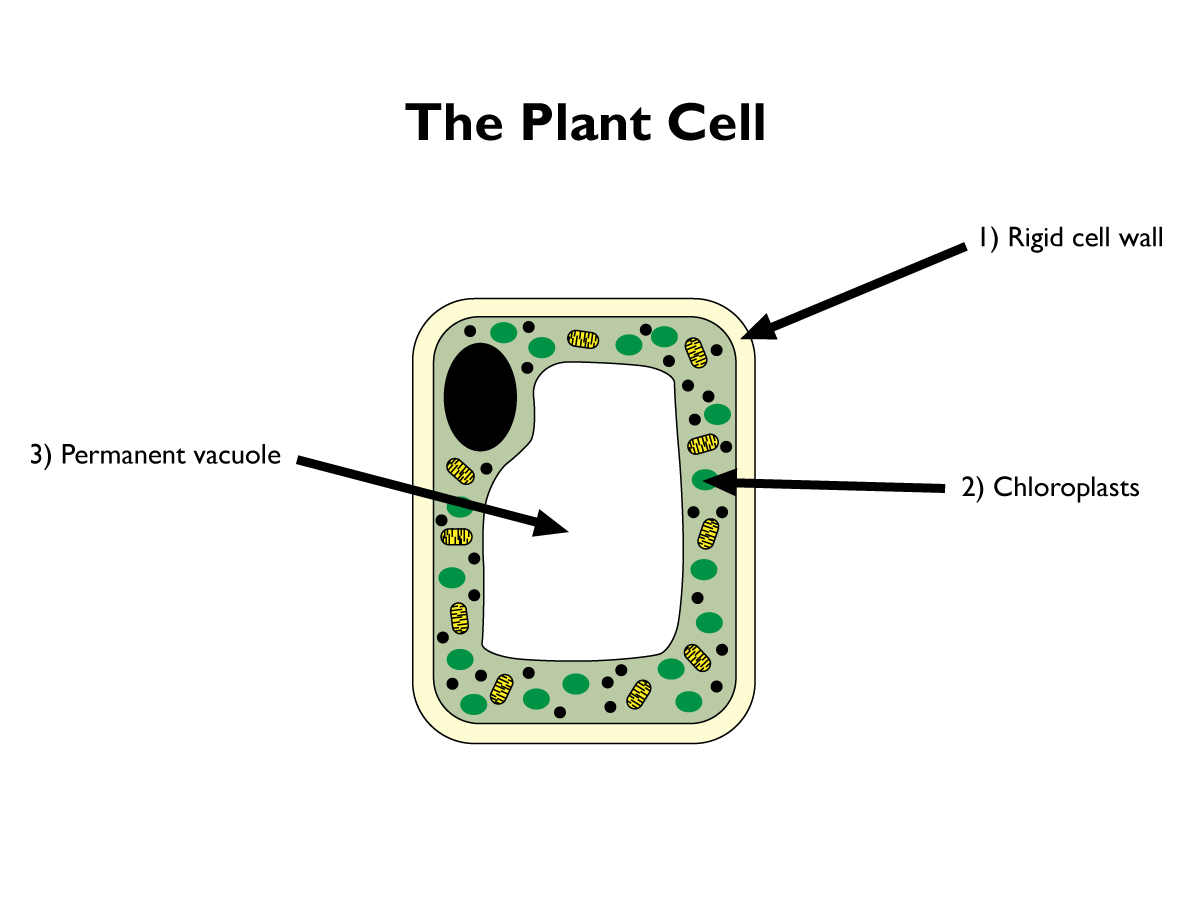
Plant cell’s usually have all of the subcellular structures an animal cell has, plus some extra parts needed for the cells function:
| Subcellular Structure | Function | |
|---|---|---|
| 1 | Rigid cell wall | Made of cellulose. Keeps the cell structure together by strengthening the cell wall |
| 2 | Chloroplasts | Where photosynthesis happens. Provides food for the plant. Contain a green substance called chlorophyll which absorbs light needed for photosynthesis |
| 3 | Permanent vacuole | Contains a sugar and salt solution, called cell sap. |
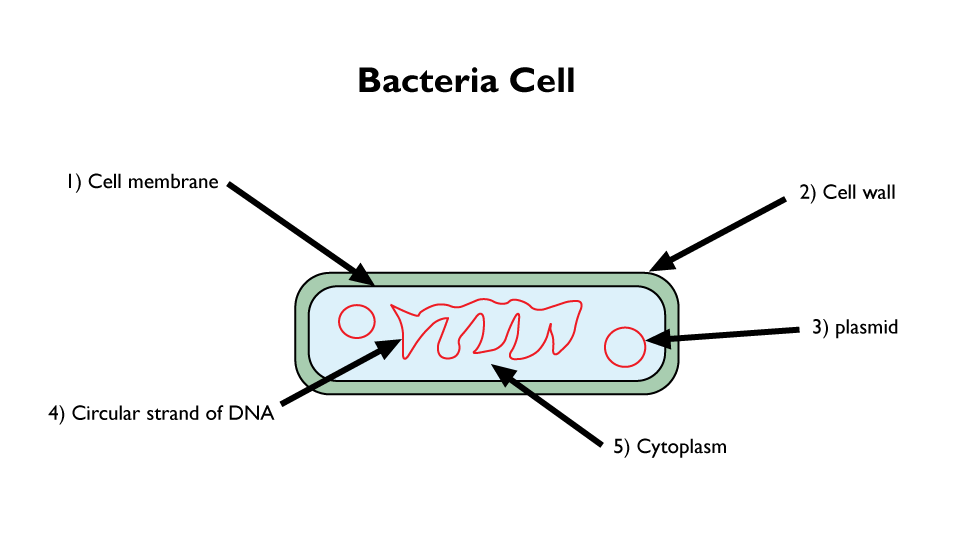
Bacteria are much smaller than animal or plant cells. They have cytoplasm and a cell membrane surrounded by a cell wall. And a circular strand of DNA instead of a nucleus.
Microscopy
Microscopes allow us to see what we cannot see with the naked eye. Light microscopes, also referred to as an optical microscope, use light and lenses to magnify subcellular structures, such as cell nuclei.
Unlike light microscopes, electron microscopes use electrons to form an image, instead of light. The development of the electron microscope has enabled scientists to view cells in a much higher magnification than older, light microscopes. This has allowed scientists to see, and understand, many more sub-cellular structures, in much finer resolutions than before. Scientists have been able to view structures such as, the internal structure of mitochondria, chloroplasts, and even smaller things such as ribosomes and plasmids.
To use a microscope effectively you need to know the following formulas. The magnification of a microscope is given in the following formula:

The formula above can be rearranged to find the image size of the specimen being magnified:

Because microscopes can help us see such minute objects, it is useful to know how to represent them by writing numbers in standard form.
Standard form helps use to take a very large decimal number (with lots of zeros), and represent it in a smaller, more manageable form.
To do this, the decimal point of a number is either shifted left or right. The number of places it is shifted, is represented by a power of 10. If it is shifted to the left, it is positive, if right, it is negative.

Cell Differentiation and Specialisation
Cell Differentiation is the change an unspecialised cell goes through to become specialised for its particular function. As a cell changes it develops new subcellular structures until it has become a new cell in the process. In animals differentiation happens in the early stages of life, as an organism develops, and is then lost. Plants, however, never lose their ability to differentiate. The cells that differentiate in mature animals are used mainly for repairing and replacing cells. Undifferentiated cells, like stem cells, have the ability to develop into different types of cells.

Specialised Animal Cells
Sperm cells are specialised for the reproduction between male and female animals. They have become specialised in transporting male DNA to female DNA.
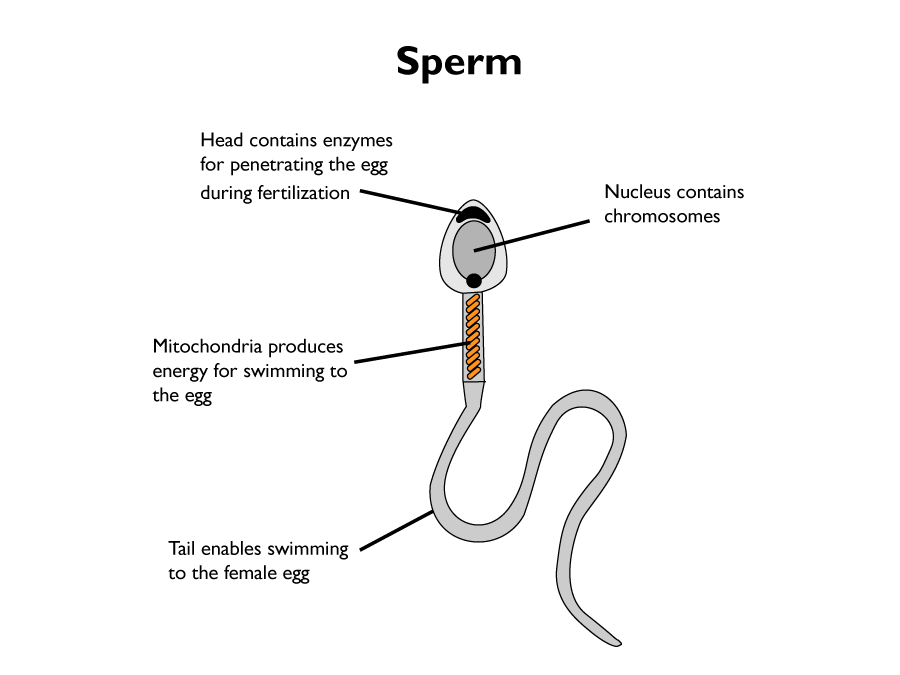
Nerve cells (neurons) have become specialised for rapid signalling of electrical signals across a neural network. They allow signals to be transported across the entire body. Because of this, they are long and slender in shape. The ends of the cell are branched, to allow many different connections to take place.
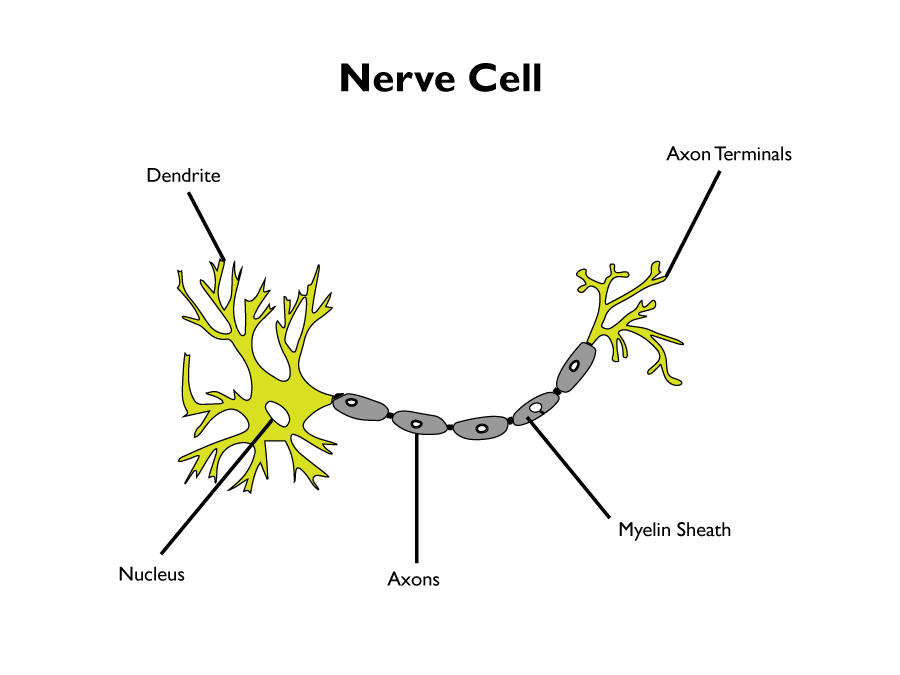
Muscle cells are specialised to contract quickly. They are very long, and contain lots of mitochondria; for energy production.
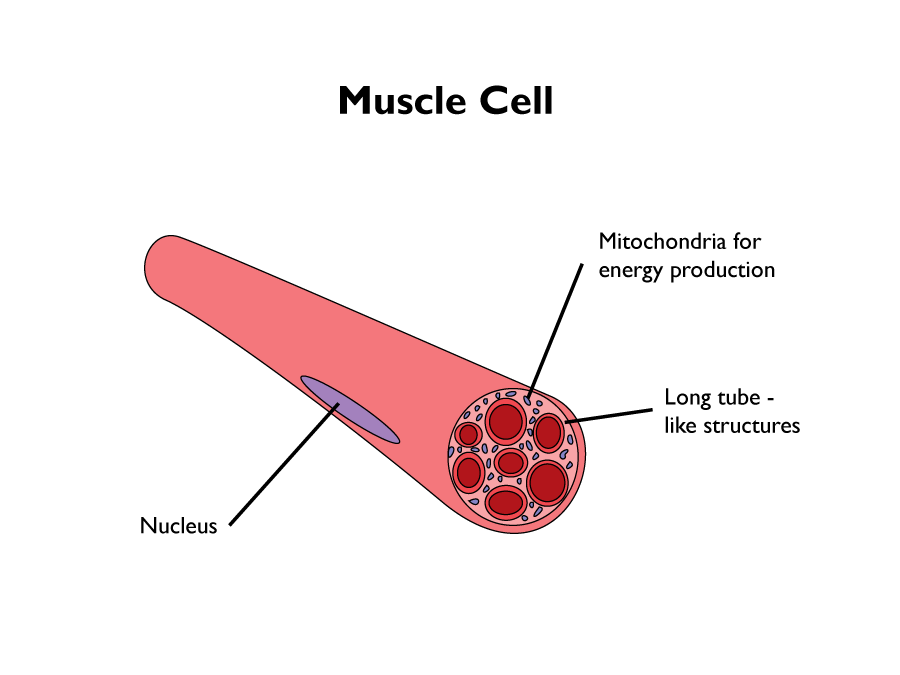
Specialised Plant cells
Root hair cells are specialised plant cells for absorbing water and minerals from the soil. They have a large surface area which enables them to absorb lots of water and nutrients. Root cells do not need chloroplasts, since under the ground there is no access to light for photosynthesis.
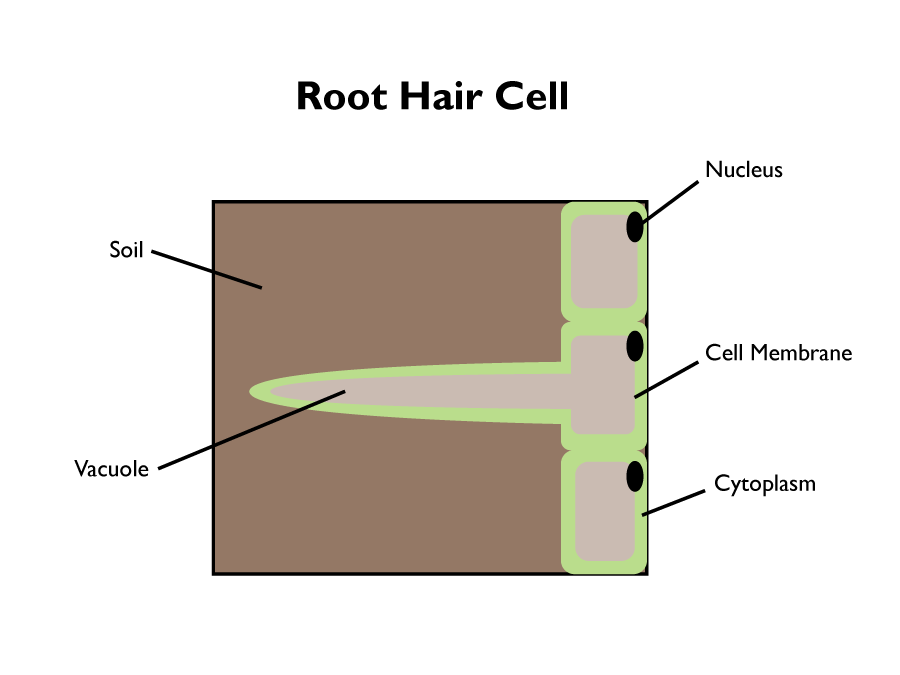
The phloem and xylem are specialised for transporting substances around the plants. They have few subcellular structures and are tubular in shape. This helps them transport nutrients such as food and water around the plant. They make up the plant vascular system.
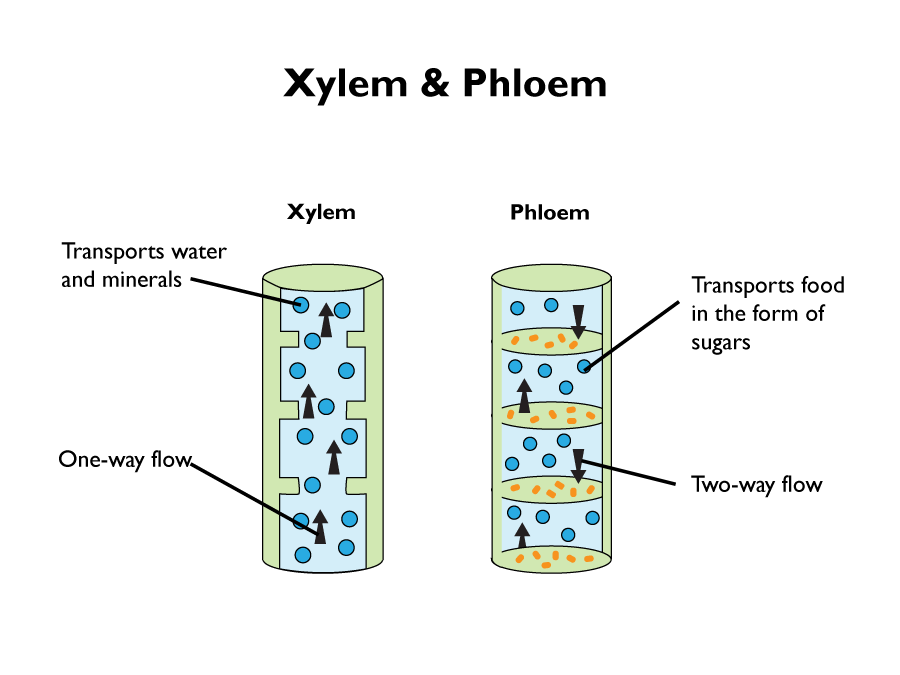
Stem Cells
Undifferentiated stem cells go through differentiation in order to form more specialised cells of any kind.

Stem cells can also replicate, forming undifferentiated copies of themselves. The best stem cells are usually found in the early embryos of an unborn child. These cells can differentiate into any type of cell. In adults they are found in the gonads or in bone marrow. However, these cells can only differentiate into a few types of cell, such as blood cells.
In therapeutic cloning an embryo is produced with the same genes as the patient. Stem cells from the embryo are not rejected by the patient’s body so they may be used for medical treatment.
Stem cells can be used to produce clones of a variety of different cells and organs. They therefore have the potential to cure many different diseases. And are already being used to cure blood related diseases, by using the stem cells from a healthy persons bone marrow. Embryonic stem cells can also be used to replace faulty cells in sick people. For example, they can be used to create insulin producing cells in people with diabetes, and nerve cells for people with spine related injures.
There are disadvantages to stem cell research, for example:
- Harvesting embryonic stem cells usually involves the death of the embryo.
- Growing organs in the lab evolves the risk of contamination with a virus or bacteria.
- Some people believe stem cells shouldn’t be used in experiments because you are dealing with a potential human life
- some of the reasons above have made stem cell research to be banned in some countries
- some campaigners feel that efforts should be spent finding and developing other sources of stem cells, as a posed to using embryonic cells
Stem Cells In Plants
Stem cells are also found in plants. They are located in the meristem, where plant growth occurs. In contrast to human stem cells, a plants stem cells can be used throughout a plants entire life. And like embryonic stem cells they can differentiate into any type of cell.
There are some benefits to stem cell use in plants, such as:
- Stem cell research into plants, isn't as controversial as it is in humans. And because of this, stem cells can be used, quickly and cheaply, to make clones of any plant.
- They can also be used to prevent some rare plants from becoming extinct.
- And can be used by farmers to grow identical clones of crops with ideal genetic traits, such as; disease resistance.
Cell Division - Chromosomes and Mitosis
In order to live, our cells, along with our DNA, need to be able to divide. The nucleus of a cell contains chromosomes made of coiled up DNA molecules. Each chromosome carries a large number of genes. Each gene controls the development of certain characteristics eg. eye colour.
In body cells the chromosomes are normally found in pairs; one from the organisms mother; and one from the father.
The Cell Cycle
The cell cycle is the cycle of growth, development and repair that body cells go through. The point at which the cell divides to create new cells is called mitosis.
Mitosis occurs when an organism is developing, growing or repairing damaged cells.
There are two main stages to the cell cycle. One before the cell divides, and one after it. The first stage involves the cell increasing its subcellular structures such as mitochondria and ribosomes. It then duplicates its DNA, one for each cell. Then it makes the long spaghetti-like strings of DNA, into neat, X-shaped pairs of chromosomes. Each arm of the chromosome an exact duplicate of the other.
Once the first stage is complete, the second stage of the cell cycle begins. Mitosis.
In mitosis one set of chromosomes is pulled to each end of the cell and the nucleus divides. Finally the cytoplasm and cell membranes divide to form two identical cells.
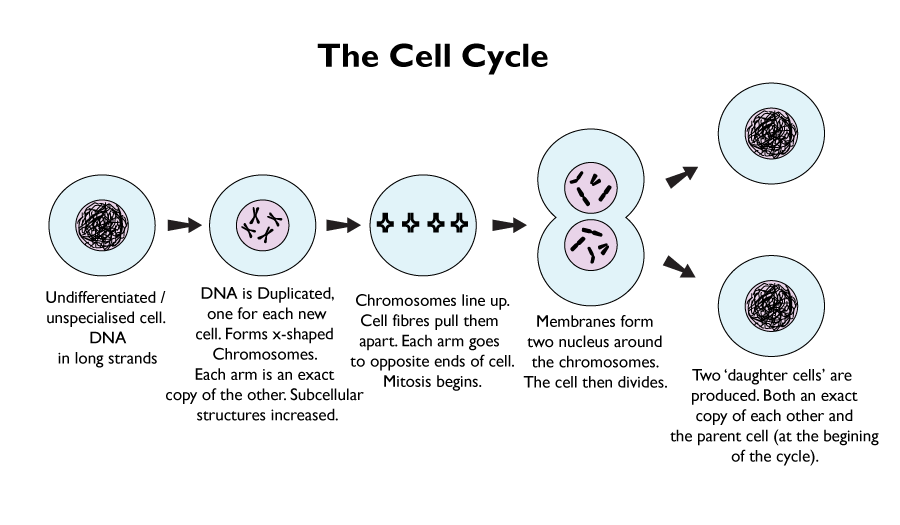
Diffusion
Substances may move into and out of cells across the cell membranes via diffusion.
Diffusion is simply the natural tendency of particles to move from an area of high concentration, to an area of low concentration.
Diffusion generally occurs in liquids and gases because the particles are free to move around, unlike a solid, where they cannot move as freely.
Factors which affect the rate of diffusion are:
- the difference in concentrations (concentration gradient)
- the temperature
- the surface area of the membrane
The diffusion rate increases the greater the concentration gradient. This is because there is more space for particles to move into from a high concentration to a low concentration. It also increases when the temperature increases. This is because the particles are moving around faster.
And lastly, the diffusion rate increases the higher the surface area because the particles have more access.
A single-celled organism has a relatively large surface area to volume ratio. This allows sufficient transport of molecules into and out of the cell to meet the needs of the organism.
Only very small substances like oxygen, glucose and amino acids can diffuse through cell membranes. Molecules such as starch and proteins are too large.
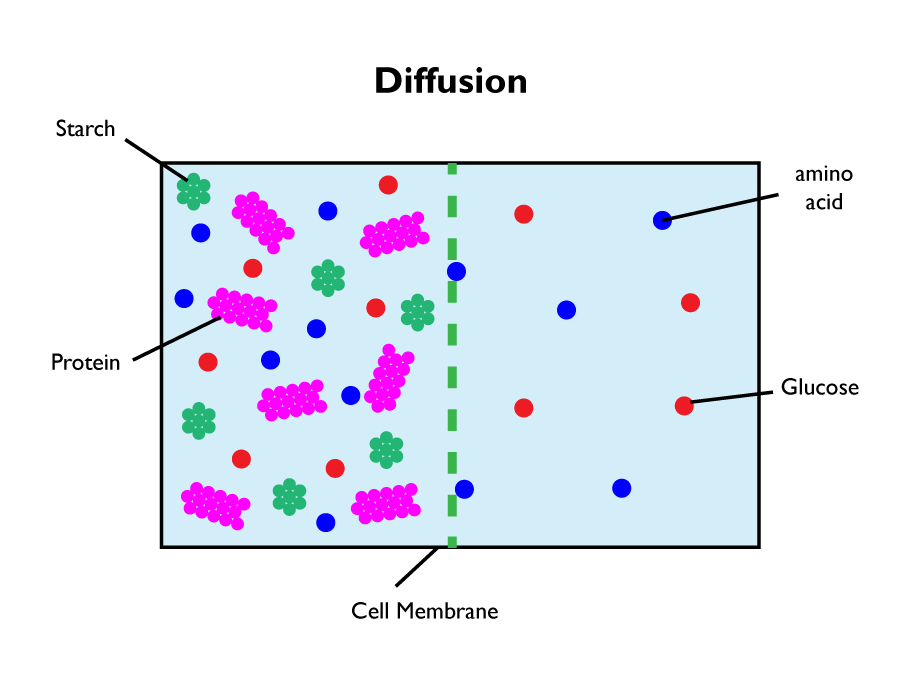
Osmosis
Water may move across cell membranes via osmosis. Osmosis is the diffusion of water from a dilute solution to a concentrated solution through a partially permeable membrane. This effect continues until an equilibrium is achieved.
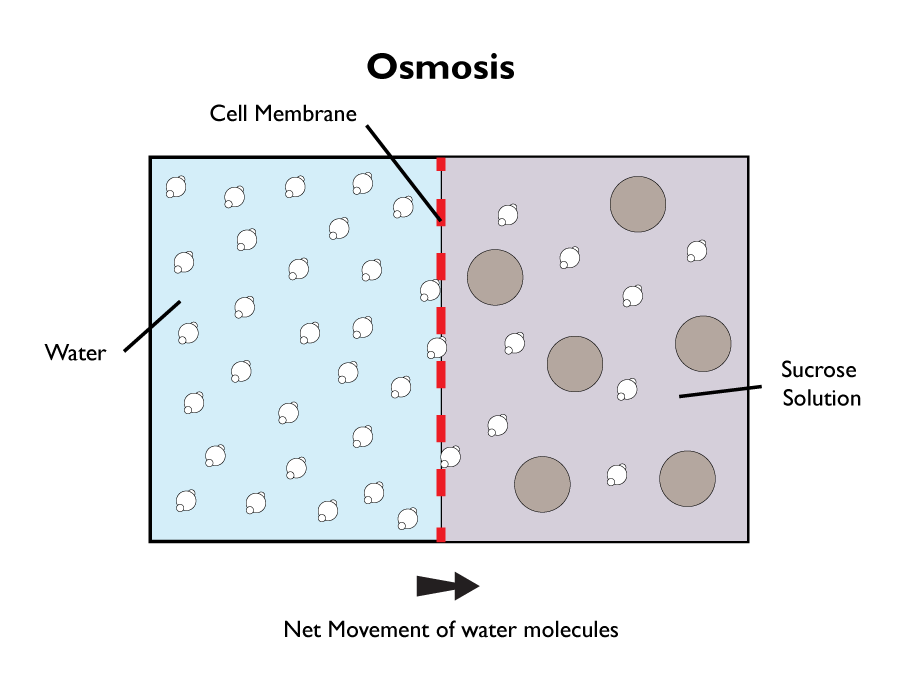
The partially permeable membrane that stands in-between the two solutions contains holes that are so small that only very small molecules such as water can pass through them.
The water molecules can travel in both directions across the permeable membrane, but the net migration is towards the sucrose solution.
Because of this migration the sucrose solution becomes more dilute. This takes place until both sides become equilibrated. Osmosis is similar to diffusion in the sense that molecules travel from an area of high pressure to an area of low pressure.
Osmosis Experiment
An experiment can be done that demonstrates the effects of osmosis. It evolves placing two potato cylinders into two different solutions. The first solution has just water in it, and the second solution has very concentrated sugar solution in it.
The dependent variable in the experiment will be the potato cylinder. The independent variable is the sugar solution. The other variables such as; the volume of solution, the temperature and time etc, must be kept the same in both solutions otherwise the experiment won’t be a fair test.
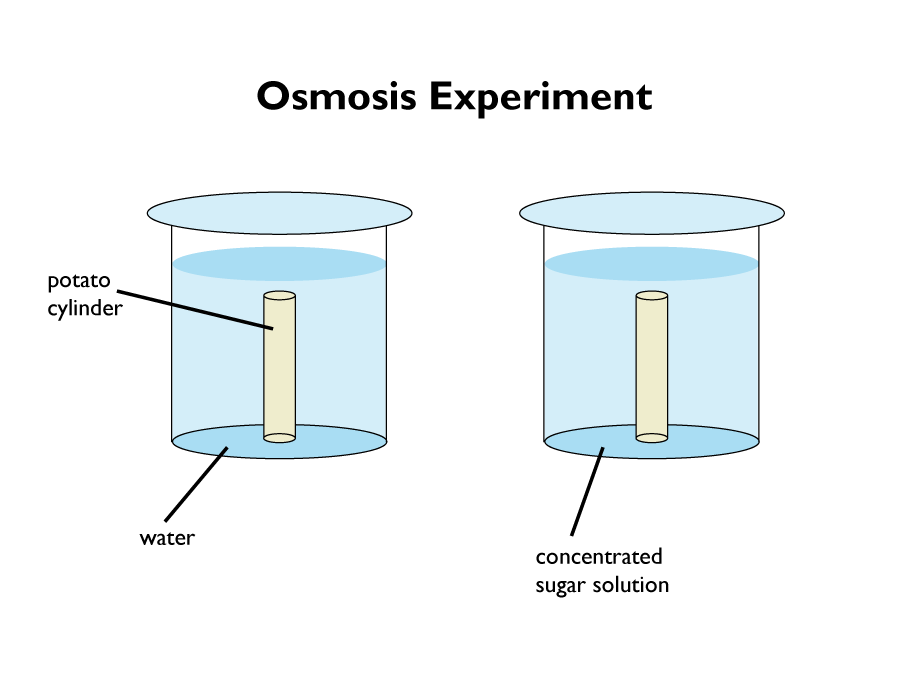
Firstly, the potato cylinders, are weighed. Then they are placed into the two solutions for around 24 hours. After the time has elapsed, the cylinders are taken out of the solutions, dried, and then weighed again.
You can compare the effects of the two solutions on the potato cylinders by calculating the percentage change of mass. An increase in mass will give a positive percentage change, and a decrease will give a negative change. The formula for this is given bellow:

Active Transport
Active transport is different to osmosis and diffusion, because it moves against the concentration gradient. The net migration of substance, moves from a more dilute solution, to a more concentrated solution. The opposite of diffusion. This process requires energy from respiration.
The tiny root hairs on the base of plants, take in minerals using active transport. Minerals are also lost the other way, by diffusion. Active transport allows mineral ions to be absorbed into the plant root hairs from very dilute solutions in the soil. Plants require ions for healthy growth. Water is taken into the root hairs by osmosis.
Humans need active transport to stop us for staving. Glucose is taken in from the gut and the kidney tubules using active transport. It does this because there is a lower concentration of nutrients in the gut to a higher concentration of nutrients in the blood. It is then transported to cells, where it is used for respiration.
It is important to note, that a key difference between active transport and diffusion, is that active transport uses energy.
Exchanging Substances
An organism is continually exchanging substances with their environment. Cells can use diffusion to take in substances and get rid of waste. The ease at which an organism can exchange substances with its environment is highly dependant on the surface to volume ratio of their systems. A smaller object usually has a higher surface to volume ratio, than a larger object.
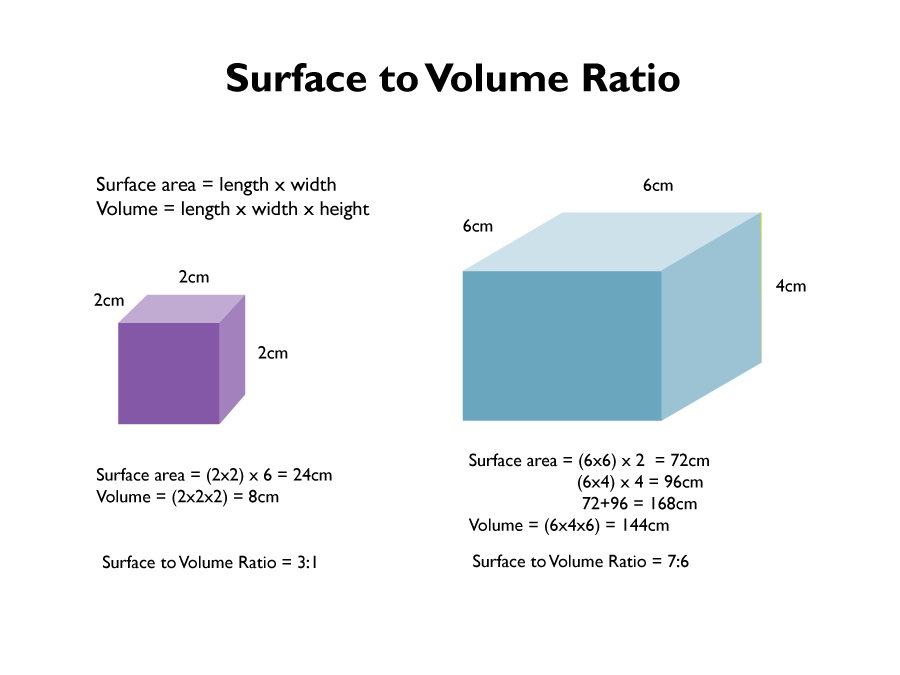
The larger an organisms exchange surface, the more gases and dissolved substances the organism can absorb. A large surface area compared to their volume, allows for an efficient exchange surface to allow enough substances to cross the semi-permeable membranes of their cells. Exchange surfaces have adapted over time to become efficient in absorbing enough nutrients an organism needs.
- They have thin membranes
- Large surface areas
- lots of blood vessels to maximize absorption rates
- gas exchange surfaces are ventilated
Gas exchange surfaces in animals are found in the lungs. The lungs transfer oxygen to the blood streams, and take Carbon dioxide away from it. It does this using millions of air sacks called alveoli, and a capillary network of blood streams.
The alveoli have a huge surface area. And a moist lining for dissolving gases. The membranes are very thin to allow for the quick absorption of gas. There is an excellent supply of blood through the network of capillaries.

The small intestine are full of tiny structures called villi. The shape of the villi are finger-like, and because of this they have an enormous surface area. This helps them to efficiently absorb digested food into the blood stream.
The digested food gets into the blood by diffusion.
They have just a single layer of cells along the surface of the villi, which allows for quick absorption of nutrients.
They also have a vast capillary network that helps to get nutrients into the blood stream.
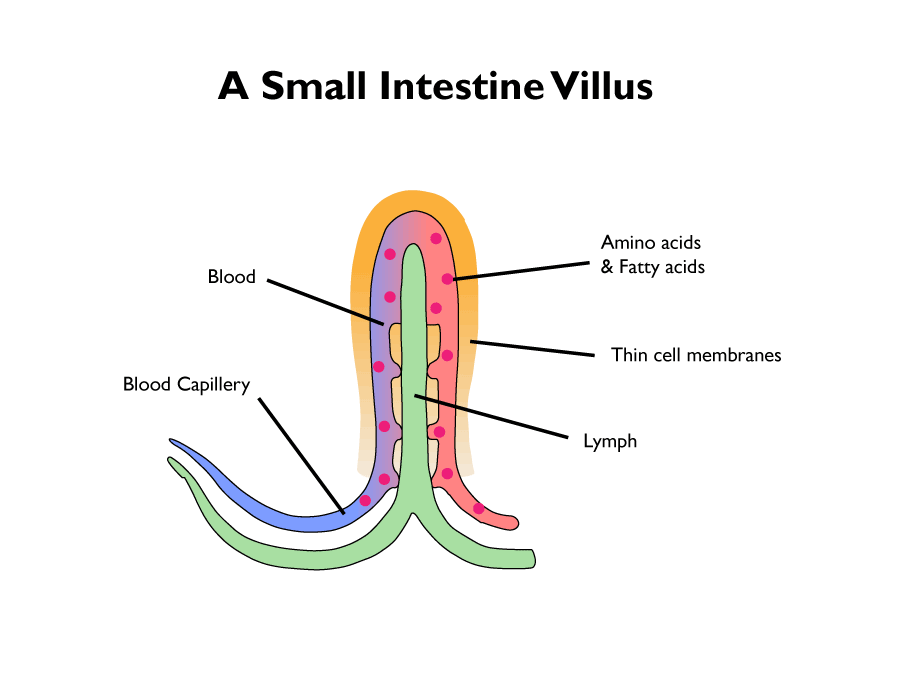
Diffusion often occurs in leaves too. Tiny pockets of air in the leafs cellular structure, allow gases and water to diffuse in and out of the cells. Carbon dioxide diffuses into the leaf, via these pockets of air, where photosynthesis then occurs. Oxygen (produced by photosynthesis) and water vapour, diffuse out of the leaf, also via these pockets of air. This is because there is a lot of it inside the leaf, and less of it in the air outside.
The flat shape of a leaf, maximises the area of exchange surface, allowing it to capture more nutrients, for the process of photosynthesis. And to efficiently expel the waste products of this process. Most of the water vapour in a leaf is lost through the stomata. The size of which is controlled by guard cells. Without the guard cells a plant would wilt. This is because the guard cells close the stomata if the plant is losing water faster than it is being replaced by the roots.
Fish also have exchange surfaces that allows for efficient gas exchange to occur. The gills of a fish contain structures called lamellae which increase the surface area of the gas exchange surface. This allows oxygen to diffuse from the water into the blood arteries in the fishes gills.
There exists a wide capillary network across the laminae to speed up the diffusion of oxygen to the blood. There is also a thin layer of cells that exist across the laminae that allow for the quick diffusion of oxygen by minimising the distance the gases have to travel.
A large concentration gradient between the water and the blood allows for quick absorption of oxygen into the blood. The blood concentration of oxygen is always lower than it is in the water, so as much oxygen diffuses from the water to the blood as possible.